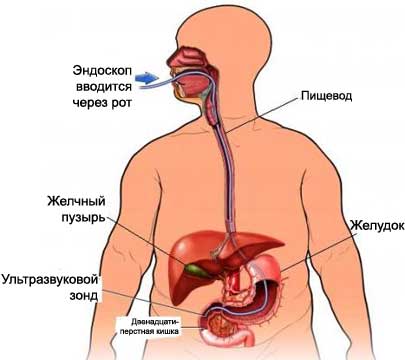Endoscopic ultrasound – Endoscopic ultrasonography – EUS
Description endoscopic ultrasound
Endoscopic ultrasound (ÉUZI) It used to study the wall of the digestive tract and other nearby organs. Ultrasound It uses sound waves, to obtain images of internal organs. When EUS ultrasonic probe is inserted into the throat or rectum and is brought to the desired portion of the gastrointestinal tract.
Reasons for endoscopic ultrasound
With EUS performed:
- Diagnosis and search for the cause of pain and disturbances in the gastrointestinal tract;
- Search and examination of tumors or abnormalities in the cavity of the pancreas, bile duct, and chest;
- Determining the prevalence of certain types of cancer and to determine their spread to lymph nodes or other vital organs;
- The selection of a sample of tissue (biopsy) to diagnose the state of authority;
- Determination of the place of aspiration needle (for drainage of cysts).
Possible complications of endoscopic ultrasound
Complications are rare, but no procedure does not guarantee the absence of risk. If you plan to EUS, you need to know about possible complications, which may include:
- Infection;
- Bleeding;
- Mild sore throat for 1-2 days;
- Reaction to sedatives;
- Regurgitation of gastric contents into the lungs;
- Damage to the gastrointestinal tract.
Factors, that may increase the risk of complications:
- Advanced age;
- The presence of other diseases.
We need to discuss these risks with your doctor before the procedure.
How is the endoscopic ultrasound?
Preparation for the procedure
- Do not eat or drink (even water), at least six hours before the test;
- Take special solution, laxative or enema place. It will cleanse your intestines. You can also go on a liquid diet;
- We need to organize a trip home after the test, if you have to take a sedative.
In most cases, before the test can be taken aspirin or other blood-thinning medications. However, it needs to be clarified by a doctor.
Procedure endoscopic ultrasound
The doctor may numb the throat using a local anesthetic, so you will not feel discomfort. It also provides a sedative. This will help you relax and reduce anxiety.
In most cases, you will lie on your left side. Thin, flexible tube, which is called an endoscope, It is inserted into the throat or anus. At the end of the ultrasonic probe is an endoscope, whereby images are formed gastrointestinal. When the study is finished, the doctor carefully removes the endoscope.
In some cases, the physician may use ultrasound, to take samples for biopsy or drain a cyst. To do this, the doctor inserts the necessary tools through an endoscope.

After endoscopic ultrasound
After researching you will be directed to the chamber to restore. The throat may be a little sick. There may be a slight abdominal distension due to air and water, are fed into the gastrointestinal tract.
When you return home, Follow these steps:, to ensure the normal recovery:
- Relax, when you are at home;
- After the restoration, you can resume a normal diet;
- Wait, until the sedative wears off, before you get behind the wheel, working with machinery or make important decisions. Maybe, you will have to wait until 24 hours;
- Take your medicines, as indicated by a physician.
How long will the endoscopic ultrasound?
15-45 minutes.
Will it hurt?
EUS is a little discomfort.
The results of endoscopic ultrasound
The doctor can immediately tell on the results. Esslin provodilasy biopsy, getting results may take longer.
Contact your doctor after endoscopic ultrasound
After returning home, you need to see a doctor, If the following symptoms:
- Pain or discomfort, which do not disappear or worsen;
- Vomiting of blood, blood in the stool or dark black stools;
- Stomach upset;
- Other painful symptoms.
